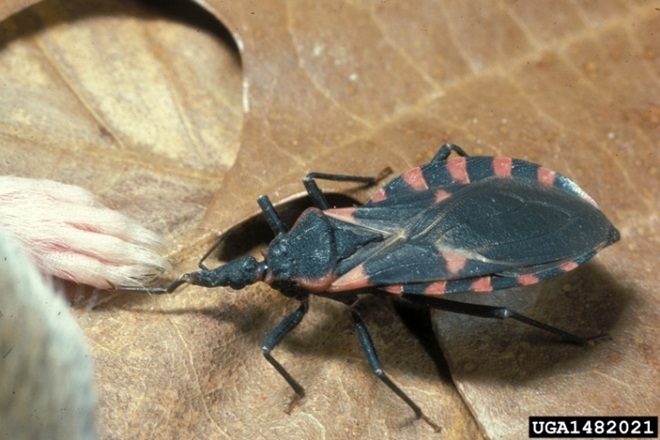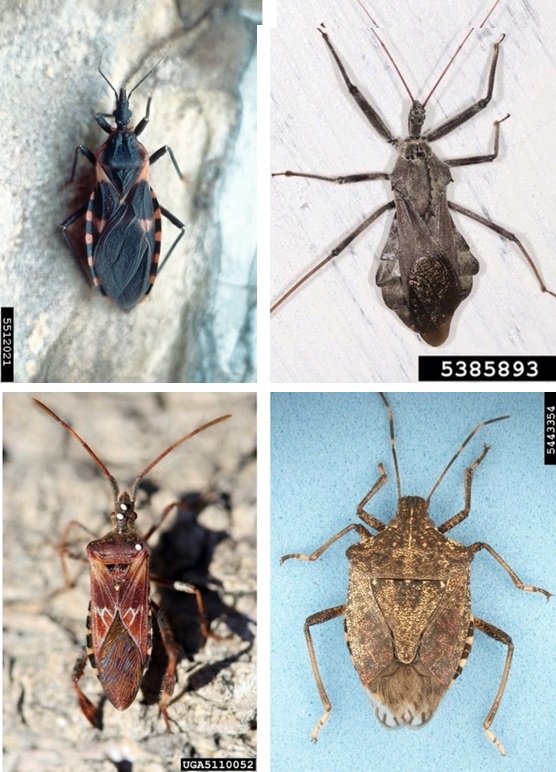Eastern Bloodsucking Conenose in Kentucky
ENTFACT-655: Eastern Bloodsucking Conenose in Kentucky | Download PDF
by Jonathan Larson, Extension Entomologist
University of Kentucky College of Agriculture
Fast Facts
- Eastern bloodsucking conenose is a species of kissing bug found in Kentucky. Conenoses may feed on humans, frogs, rats, raccoons, cats, dogs, and other animals.
- In Central and South America kissing bugs are vectors for Chagas disease, which affects more than 8 million people in that region. After feeding on a host, kissing bugs may defecate near their feeding site. This fecal material may be wiped or rubbed into the wound, transferring the pathogen and infecting the individual.
- Eastern bloodsucking conenose can carry the pathogen responsible for Chagas disease. However, they are considered a relatively poor vector as they rarely defecate on their host after feeding.
- Pest proofing the home by sealing possible entry points, reducing outdoor lighting, and in extreme situations, treated cracks and crevices of the home can help manage conenose issues.
Biology of Eastern Bloodsucking Conenose
The Eastern bloodsucking conenose is a type of kissing bug that can be found across Kentucky. Kissing bugs are blood feeding parasites and are members of the Hemiptera, also known as true bugs. Hemiptera includes other insects like aphids, stink bugs, bed bugs, cicadas, and many more. All true bugs have piercing sucking mouthparts and go through gradual metamorphosis. Conenoses start life as an egg and progress through eight nymphal instars, or stages, to reach adulthood. To go from one stage to the next, they must take a blood meal.

Figure 1: Eastern bloodsucking conenoses are large insects with a distinctive black and orange coloration and distinctive patterns on the edge of their abdomen. Photo by- Sturgis McKeever, Georgia Southern University, Bugwood.org
Adult conenoses are about 3/4th inch long, dark in coloration, and have distinctive orange or red-orange squares on the border of their body.
Kissing bugs get their common name for their penchant of biting human hosts near the mouth. In general, this is done when humans are asleep to minimize chance of detection. Eastern bloodsucking conenose will also take bloodmeals from frogs, rats, raccoons, cats, and dogs. They can be found in tree cavities, near doghouses, and by animal enclosures to have access to these hosts.
Other Insects Confused with Conenoses
The eastern bloodsucking conenose can be confused with multiple, more common insects. In Figure 2, in the upper left corner is an eastern bloodsucking conenose, then going clockwise, a wheel bug, a western conifer seed bug, and then a brown marmorated stink bug. The wheel bugs are differentiated from conenoses by the large cog that projects from the top of their thorax. Western conifer seed bugs have flattened legs that resemble an oar or paddle. Brown marmorated stink bugs are much lighter in color than the conenose.

Figure 2: Images by Kansas Department of Agriculture, Joseph Berger, David Cappaert, and Susan Ellis, Bugwood.org respectively.
Issues Associated with Conenoses
In Central and South America, kissing bugs are responsible for vectoring the pathogen that causes Chagas disease. Chagas is also found in North America but is diagnosed less commonly here. Chagas is caused by a pathogen called a trypanosome. In the acute phase of Chagas, which would occur soon after transmission, the CDC describes that the patient may experience fever and/or swelling around the bite site. In chronic cases, those who suffer from Chagas may have heart and digestive tract issues.
Chagas can be vectored in multiple ways, but when kissing bugs serve as the vector, the transfer of the Chagas pathogen comes from a kissing bug biting a person and then defecating on the person’s face, often near the bite site. Upon waking, the person may wipe or itch at the bite, pushing the fecal material into the wood and completing the vectoring process.
The eastern bloodsucking conenose can and will bite humans and they sometimes may test positive for the pathogen responsible for Chagas. However, they are not commonly considered to be competent vectors for Chagas. This is because, unlike their relatives, they tend to not defecate while engaged in feeding or soon after feeding while they would be on the sleeping human. Without the infected feces near the bite, it is relatively less likely Chagas will be acquired. If you find a conenose in your home, it is extremely unlikely you will end up with Chagas disease. Of course, if you feel concerned or ill, please consult with a medical professional.
Management
Even if you are not at distinct risk of infection, bloodsucking parasites are still not welcome in our homes. Conenoses are best prevented by using pest proofing methods like sealing cracks and gaps around windows, walls, roofs, and doors, by repairing screens and windows, and by closing holes and cracks leading to the attic/crawl spaces. Conenoses are also attracted to lights and will fly at houses with outdoor lighting. Turning off outdoor lights or changing timers/motion detection can reduce light attraction, as can switching to “bug repellent lightbulbs”. Finally, checking pet or animal domiciles for bugs is also practical.
Those who live near wooded areas are more at risk and should be proactive. You may also need to perform pest control for things like rats, raccoons, etc. that are acting as hosts to the conenose. Insecticides are generally not necessary but pyrethroid products applied as dusts to cracks and crevices can be used for serious infestations.
For more information consult the Center for Disease Control (CDC) website on Chagas and kissing bugs: https://www.cdc.gov/parasites/chagas/gen_info/vectors/index.html
Issued: 07/22
CAUTION! Pesticide recommendations in this publication are registered for use in Kentucky, USA ONLY! The use of some products may not be legal in your state or country. Please check with your local county agent or regulatory official before using any pesticide mentioned in this publication.
Of course, ALWAYS READ AND FOLLOW LABEL DIRECTIONS FOR SAFE USE OF ANY PESTICIDE!
